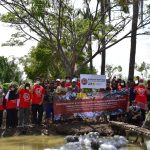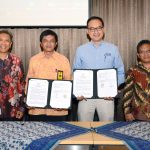DAFTAR SDGS-3
| No. | SDG | Metric | Year | Collaborator | Evidence | Evidence in Public | Statement |
|---|---|---|---|---|---|---|---|
| 1 | 3 | 3.1 Research on SDG 3 | 2019 | Prihartono NA, Djuwita R, Mahmud PB, Haryanto B, Helda H, Wahyono TYM and Dignam T. Prevalence of Blood Lead among Children Living in Battery Recycling Communities in Greater Jakarta, Indonesia. International Journal of Environmental Research and Public Health. 2019:16 (7), 1276 |
https://doi.org/10.3390/ijerph16071276 | This study aimed to assess the prevalence of blood lead levels (BLLs) among children 1 to 5 years old who reside near and distant to informally used lead-acid battery (ULAB) recycling locations and examine risk factors for elevated BLLs. | |
| 2 | 3 | 3.1 Research on SDG 3 | 2019 | Pramitha E and Haryanto B. Effect of Exposure to 2.5 μm Indoor Particulate Matter on Adult Lung Function in Jakarta. Osong Public Health Res Perspect 2019;10(2):51−55. April 2019. | https://www.ncbi.nlm.nih.gov/pmc/articles/PMC6481574/ | A study to assess whether there is an association between indoor PM2.5 concentration and lung function impairment among the adult population in Jakarta, Indonesia. | |
| 3 | 3 | 3.1 Research on SDG 3 | 2020 | Pratiwi DA and Haryanto B. 2020. Effect of particulate matter 2.5 exposure to urinary malondialdehyde levels of public transport drivers in Jakarta. Reviews on environmental health. | https://doi.org/10.1515/reveh-2020-0017 | A study to identify the association between PM2.5 exposure and other characteristics with urinary MDA levels among public transport drivers in Jakarta. | |
| 4 | 3 | 3.1 Research on SDG 3 | 2020 | Haryanto B, Lestari F, Nurlambang T. 2020. Extreme Events, Disasters, and Health Impacts in Indonesia. Book chapter: Akhtar R Editor. Extreme Weather Events and Human Health. Springer Nature January 2020. | https://link.springer.com/chapter/10.1007%2F978-3-030-23773-8_16 | Extreme weather events caused by climate change may destroy many components of environment and facilities, direct physical harm, loss of income, psychological stress, and other direct and indirect human health. |
|
| 5 | 3 | 3.1 Research on SDG 3 | 2020 | Haryanto B. 2020. Indonesia: country report on children’s environmental health. Reviews on Environmental Health. REVEH 35(1): 41–48. | https://www.degruyter.com/document/doi/10.1515/reveh-2019-0088/html | A research provides an overview of common disease risks in Indonesian children, including: acute hepatitis A, diarrheal diseases, dengue and malaria due to lack of water supply and sanitation, vectors, and parasites; asthma, bronchopneumonia, chronic obstructive pulmonary disease (COPD) and acute respiratory infections (ARIs) due to air pollution and climate change; some chronic diseases caused by toxic and hazardous waste; and direct or indirect consequences due to the occurrence of disasters and health emergencies. | |
| 6 | 3 | 3.1 Research on SDG 3 | 2020 | Djalante R, Haryanto B, et al. 2020. Review and analysis of current responses to COVID-19 in Indonesia: Period of January to March 2020. Progress in Disaster Science: 6 (2020) 100091. | https://www.sciencedirect.com/science/article/pii/S2590061720300284 | A study aims to provide detailed reporting and analyses of the present rapid responses to COVID-19, between January and March 2020, in Indonesia. The study particularly highlight responses taken by the governments, non-government organisations and the community. | |
| 7 | 3 | 3.1 Research on SDG 3 | 2020 | Haryanto B and Djafri D. 2020. Air Pollution and School Children Respiratory Diseases in Indonesia: A Cohort Study. ASM Science Journal 13(5):24-29. | https://www.scopus.com/record/display.uri?eid=2-s2.0-85087818084&origin=inward&txGid=d4c24996d9efb60379941720b754d133&featureToggles=FEATURE_VIEW_PDF:1 | A study to determine the effect of air pollution to respiratory diseases among elementary school children in Jakarta. |
Belum ada data
Belum ada data
DAFTAR SDGS-3






